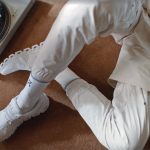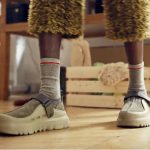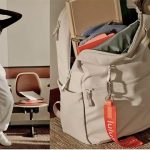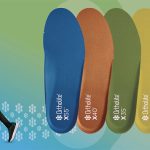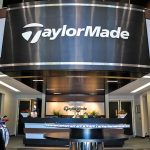Wolverine Worldwide reported fourth-quarter results that were in line with guidance but officials on a analyst call gave a bullish outlook for profit improvement in the back half of 2023 as inventory and expense reduction efforts are already starting to pay off.
Shares of Wolverine were trading up about 7 percent in mid-afternoon trading on the New York Stock Exchange.
On January 11, Wolverine said an acceleration of its inventory reduction efforts was expected to pressure fourth-quarter earnings toward the lower end of guidance given with the release of third-quarter results.
In the fourth quarter ended December 31, revenues were $665.0 million, up 4.6 percent on a reported basis and 8.4 percent on a constant currency basis. Guidance had called for revenue of approximately $665 million.
Earnings on an adjusted basis in the quarter were a loss of 15 cents a share against earnings of 37 cents a year ago. Guidance had called for adjusted EPS in the range of a loss of 15 cents to a loss of 5 cents.
The quarter’s loss reflects a reduction in gross margins to 33.7 percent versus 41.3 percent in the prior year due to the acceleration of end-of-life inventory liquidation, increased promotions, and a higher mix of international distributor sales that carry relatively lower gross margin. Adjusted SG&A expenses were 35.8 percent of revenue, up 50 basis points higher than the prior year primarily due to higher storage and handling costs as a result of elevated inventory levels.
The net loss in the quarter loss came to $361.6 million, or 4.59 a share, from a loss of $188.3 million, or $2.37, a year ago. The loss in the latest period reflects the non-cash impairment of Sperry and Sweaty Betty intangible assets primarily driven by a significantly higher discount rate assumption tied to their valuation at the time they were acquired. The latest quarter also included impairment costs of approximately $10 million in severance and other separation costs related to the workforce reduction completed in December.
For the full year, revenues of $2.68 billion represented growth of 11.2 percent versus the prior year and 14.1 percent on a constant currency basis. Earnings on an adjusted basis were down 23.8 percent to $1.41 a share from $1.85 a year ago.
On a call with analysts, Brendan Hoffman, celebrating his one-year anniversary as Wolverine’s president and CEO, said the company is already making significant progress stemming from the “100 Day Action Plan” put in place during the quarter that included four key priorities.
The first was the realignment of its brand group structure announced in November to group brands with similar attributes together, enabling them to more easily collaborate and share best practices. The new structure now includes Active Group (Merrell, Saucony, Sweaty Betty, Chaco); Work Group (Wolverine, Cat, Bates, Harley-Davidson, HyTest); and Lifestyle Group (Sperry).
The second priority involved cost reduction. A Profit Improvement Office that has been established identified $150 million in annual run rate profit improvements, including at least $65 million is expected to be achieved in 2023. The office is also focused on continuous process improvement initiatives, including redesigning the supply chain planning process.
A third priority was to review its portfolio “to focus resources on the businesses and brands that will drive the highest return for our shareholders. This includes further investments in Merrell, Saucony’s lifestyle businesses, and expanding Sweaty Betty’s global business.” Towards that goal, Wolverine on February 8 announced the sale of Keds and licensing of Hush Puppies for North America to Designer Brands, the parent of DSW. The Wolverine leather business is also being divested.
Finally, a fourth priority is improving working capital and reducing leverage. Highlighting some progress, Hoffman said year-end inventory was down approximately $93 million versus the third quarter and lower than its November guidance by $50 million. The fourth-quarter’s operating free cash flow was nearly $300 million and the company’s bank defined leverage ratio of 2.7 compared to 3.4 at the end of the third quarter. Said Hoffman, “The meaningful progress we made over the last 100 days sets a foundation for further improvements in 2023. We expect to reduce inventory to normal levels in the third quarter of the year and drive significant operating free cash flow.”
Hoffman also highlighted healthy momentum among most of its bigger brands.
Among its segments, sales in the Active Group (Merrell, Saucony, Sweaty Betty, Chaco) rose 16.8 percent (+23.0 percent currency-neutral) in the quarter to $397.6 million. In the year, Active Group sales were $1.57 billion, up 19.0 percent on a reported basis and 23 percent on a currency-neutral basis.
Merrell’s Sales Climb 27 Percent In Fourth Quarter
Merrell’s sales rose 27.0 percent (+31.2 percent currency-neutral) in the quarter, to $193.9 million. In the year, Merrell’s sales were $764.2 million, up 18.0 percent on a reported basis and 21.6 percent on a currency-neutral basis.
Hoffman said Merrell’s fourth quarter performance was driven by global brand strength across categories and a relatively easy comparison to the prior year when Vietnam factory closures resulted in the lack of inventory. The growth benefited from a successful repositioning of the Moab franchise, its “purpose-led” brand messaging, and a broadening of its marketing efforts that helped the brand raise awareness and attract new consumers, including younger ones and more women. Hoffman said Merrell secured “meaningful” increases in market share in the second half of 2022. Merrell’s direct-to-consumer business was up 16 percent in the fourth quarter and now accounts for over 40 percent of Merrell’s sales in the U.S.
“As we look ahead, we are confident that Merrell will continue to leverage its leading positioning in its core hike business, along with increased traction in trail running,” said Hoffman. “We believe that our highest growth opportunity for Merrill is to expand our lifestyle business.”
Merrell’s lifestyle product line, 1TRL, is expanding its reach with retail partners and investing in activations, including a collaboration with men’s wear designer Reese Cooper and opening a New York City pop-up in early February featuring a limited-edition collaboration. For 2023, Merrell’s revenues are expected to grow mid-single digits with high-teens growth in the first quarter versus an easier comparison.
Saucony’s Sales Jump 25 Percent In Fourth Quarter
Saucony’s sales grew 24.8 percent (30.2 percent currency-neutral) to $121.3 million for the quarter. Sales for the running brand reached $505.3 million in the year, up 6.1 percent on a reported basis and 10.1 percent on a currency-neutral basis.
Hoffman said that similar to Merrell, Saucony’s fourth quarter performance was driven by updated core franchises, including the Endorphin and Triumph. E-commerce grew 31 percent as the brand integrated a centralized e-commerce commercial team directly into the brand team. Saucony’s Endorphin Pro 3 was called out positively in editorial reviews by GQ while the Ride 15 One earned “Best Cushioned” running shoe in Runner’s World.
Saucony’s China joint venture again had a “very strong” quarter with sales tripling for the year. Said Hoffman, “Our multi-channel strategy is working well including the addition of eight new stores during the quarter. We expect revenue from our China JV to double in ’23.”
Hoffman said the highest priority for Saucony is to extend its reach beyond the core runner to everyday active and lifestyle consumers. Several related products and marketing initiatives are being planned. A related focus will be on expanding Saucony’s Originals business, which remains robust in Italy. For 2023, Saucony is expected to deliver mid-single digit growth with high-single-digit growth expected in the first quarter.
Sweaty Betty Expands 5 Percent Currency-Neutral
At Sweaty Betty, sales were down 7.0 percent (+5.1 percent currency-neutral) in the quarter, to $72.8 million. Assuming Wolverine acquired Sweaty Betty at the start of 2021, full-year constant currency revenues declined 4 percent to $212 million. Wolverine acquired Sweaty Betty in August 2021.
“The retail environment in the U.K. remains challenging but Sweaty Betty navigated the holiday quarter well,” said Hoffman. Store comps in the U.K. were positive, driven by new customer acquisition initiatives as well as head-to-toe merchandising efforts to increase units per transaction. Marketing activations enabled the brand to acquire 12 percent more new customers in the U.K. and 33 percent more new customers in the U.S. in the fourth quarter, a shift from a negative trend the brand had been seeing.
Said Hoffman, “Currently, our U.S. wholesale channels have begun to stabilize with improvements in logistical operations and robust reorder activity showing the continued demand from our key partners. Brand margins were negatively affected by increased discounting to compete in a highly promotional U.K. market. However, we are encouraged that the brand ended the quarter with an improved inventory position.”
In 2022, Sweaty Betty opened 18 new standalone stores and concessions in the U.K., Northern Ireland, Hong Kong and Singapore, as well as a pop-up in China. Ten new stores are planned for the current year, primarily in the U.K. and Ireland. The priority for the brand is to stabilize the business in the brand’s home market in the U.K. and Ireland while improving profitability through synergies from integration efforts. Growth of low-single digits is targeted for 2023 with a low teen decline expected in Q1.
Work Group Sales Climb 4 Percent
Sales at the Work Group (Wolverine, Cat, Bates, Harley-Davidson, HyTest) increased 3.3 percent (+4.4 percent currency-neutral) in the quarter to $154.5 million. Sales in the year reached $590.5 million, up 7.6 percent on a reported basis and 8.2 percent on a currency-neutral basis.
Hoffman said the growth reflects strength across its key specialty retail accounts, increases across the farm and fleet channel and e-commerce revenue growth. Wolverine and Cat led the way and maintained their number one and three positions for trade work footwear in 2022.
Looking ahead, the Work Group segment is expected to benefit from favorable trends, including the increase in work participation from the Hispanic population. Bates is being tested this year as a private label at Walmart.
The Lifestyle Group, which excludes Sperry as well as Keds and Hush Puppies prior to their divestiture) achieved sales of $100.7 million in the quarter, down 20.6 percent on a reported basis and 19.7 percent currency-neutral. For the year, sales were $447.5 million, down 6.2 percent on a reported basis and 5.5 percent on a currency-neutral basis.
Sperry’s Sales Slide 28 Percent
Sales at Sperry were down 28.0 percent (-27.9 percent currency-neutral) to $68.0 million in the quarter. For the year, Sperry’s sales reached $294.2 million, down 10.2 percent on a reported basis and 10.0 percent on a currency-neutral basis.
Hoffman said Sperry’s decline reflected lower sell-throughs in certain boot styles as well as a slowdown in the boat category that resulted in wholesale cancellations. Hoffman said, “Sperry continues to experience headwinds in the U.S. marketplace across all channels. In 2022, the root cause of our underperformance was product. Customers love Sperry for its core franchises, but we did not proactively modernize quickly enough based on trends between 2018 and 2022.”
He said more focus was placed on categories not as relevant to Sperry’s DNA and core decline from 70 percent of styles to less than 50 percent and a goal for 2023 is the stabilize the business with a focus on core boat styles.
“Our objective is to make boat shoes cool again through increased collaborations with designers that are relevant to our nautical theme and capitalize on the increasing consumer preference for spending on vacations and casual footwear for everyday use,” said Hoffman. “We know Sperry can be top of mind for that vacation mindset with its classic and timeless style. We expect Sperry revenue to decline high single digits in fiscal 23 with A similar decline the first quarter.”
Inventory at quarter-end was $745.2 million which does not include $43.1 million from held-for-sale businesses. Inventory was down approximately $90 million versus the previous quarter.
Outlook
“As we transition to 2023, we’re focused on igniting growth across our Active Group, continuing our positive momentum in Work and quickly addressing our underperforming brands, all while increasing the efficiency of our business model,” said Hoffman. “The retail environment remains volatile and we continue to see some wholesale partners delay orders to allow more time to assess consumer demand trends. However, with our improving inventory position and a more responsive supply chain, we are better positioned to service the business.”
Wolverine’s outlook for 2023 calls for:
- Revenue to be in the range of $2.53 billion to $2.58 billion, representing growth of approximately 0.0 percent to 2.0 percent and constant-currency growth of approximately 1.0 percent to 3.0 percent;
- Gross margin to be approximately 41.2 percent and adjusted gross margin to be approximately 42.0 percent;
- Operating margin to be approximately 8.7 percent, and adjusted operating margin to be approximately 8.5 percent; and
- Diluted EPS to be between $1.50 to $1.70 and adjusted diluted earnings per share are expected to be between $1.40 to $1.60. These full-year EPS expectations include an approximate $0.14 negative impact from foreign currency exchange rate fluctuations.
Hoffman said profitability is expected to improve sequentially in the year as inventory is right-sized and savings from its profit improvement plan builds.
He added, “We also expect to benefit as we introduce more newness and innovation across brands and continue our storytelling and full-funnel marketing journey. We are now a leaner and more agile organization better positioned to accelerate our profit growth and invest behind our core brands to enable them to reach their full potential. While we are disappointed that our performance in 2022 fell short of our original expectations, we believe we now have the organizational structure the team and the strategy in place to deliver improved performance in 2023 and return to 12 percent operating margins in fiscal year 2024.”
Photo courtesy Sweaty Betty


